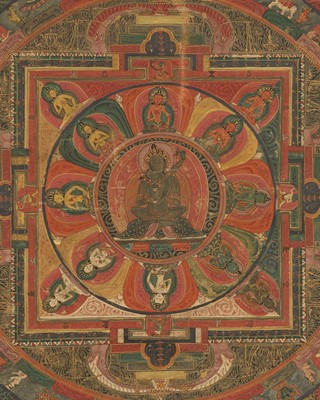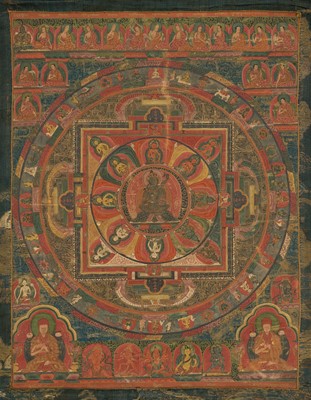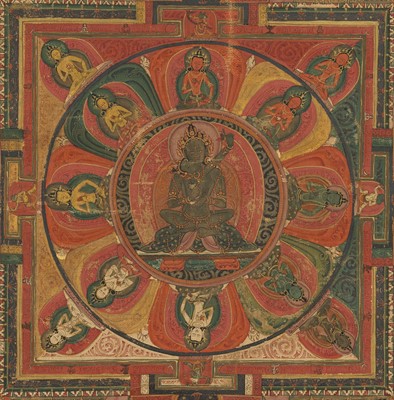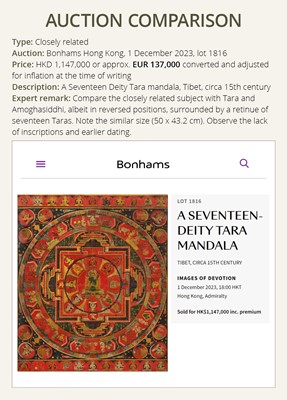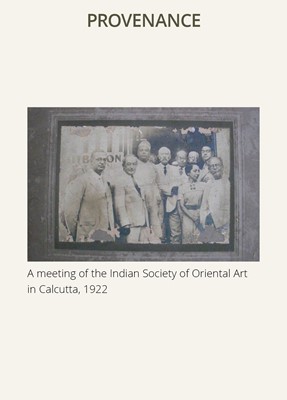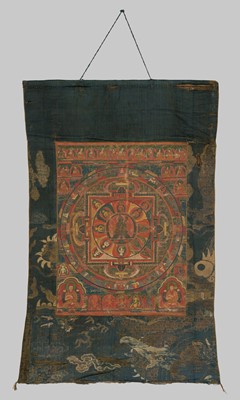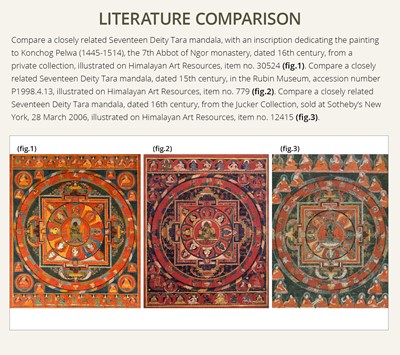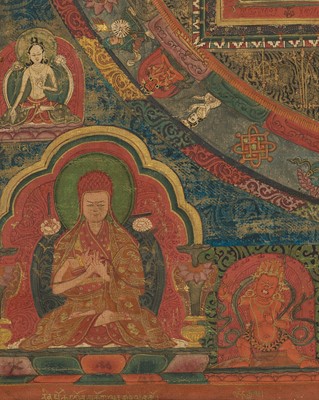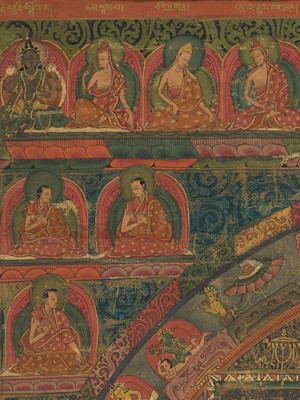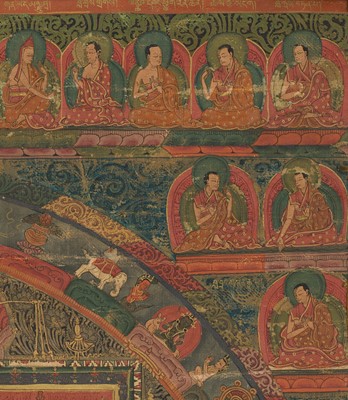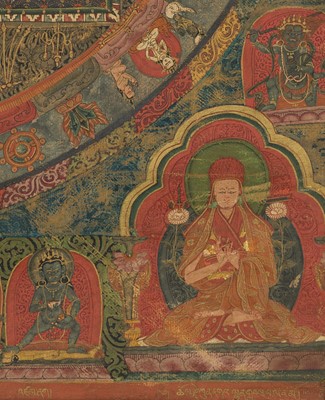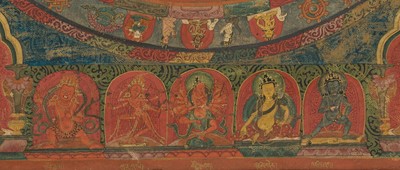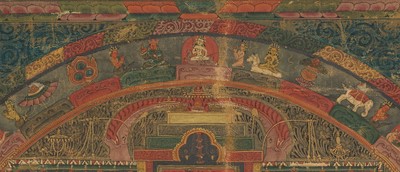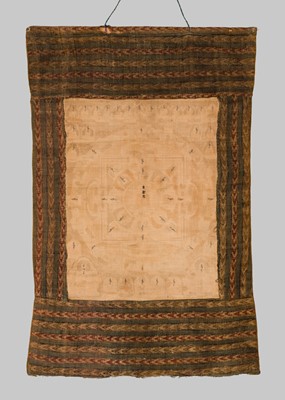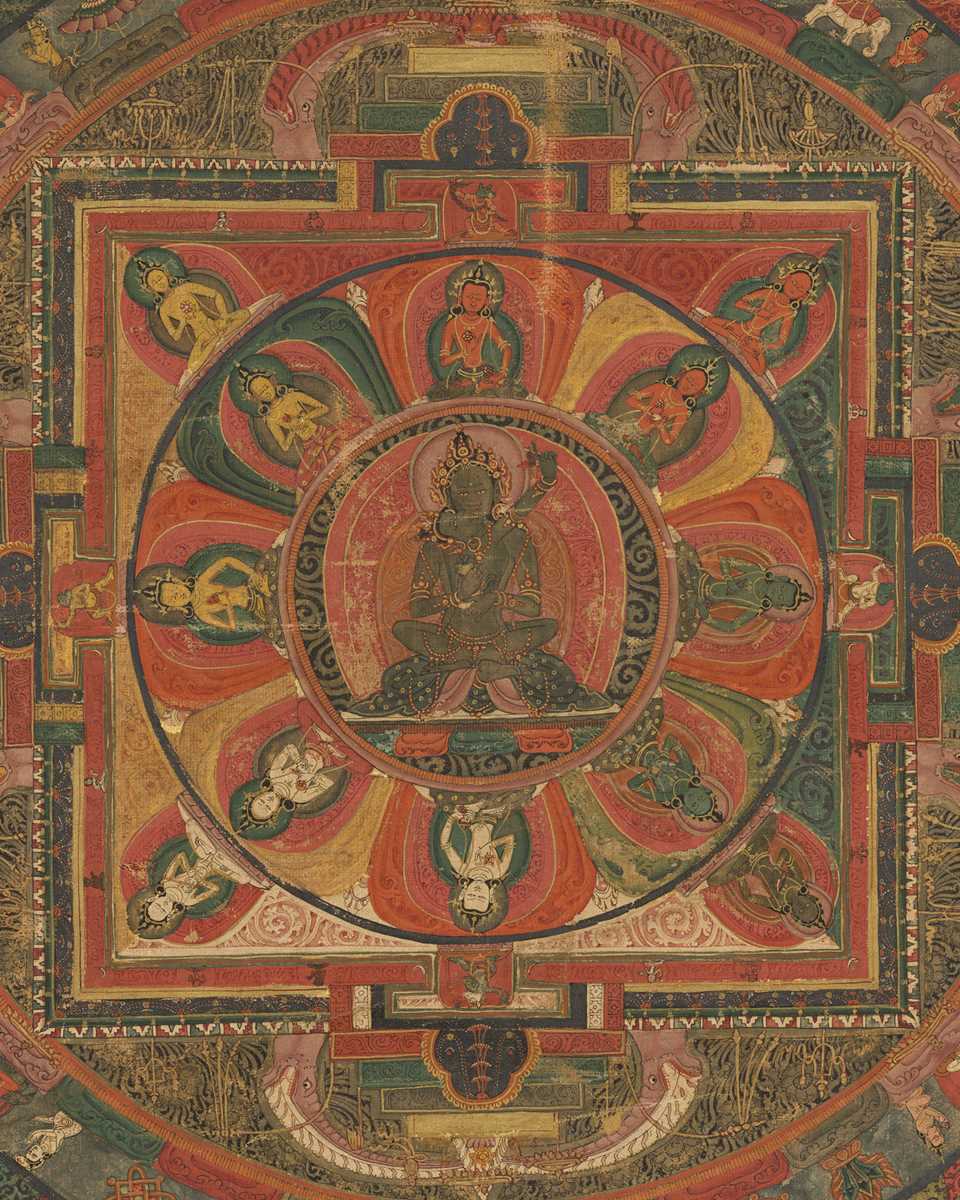Until 2nd Apr, 2025
Buy it now
A RARE AND IMPORTANT THANGKA OF THE SEVENTEEN-DEITY TARA MANDALA, FIRST HALF OF 16TH CENTURY
LOT 22 - FAS0424
Central Tibet, circa 1535-1550. Distemper and gold on cloth. Mounted as a hanging scroll on a fine Chinese silk brocade frame dating from the Ming dynasty (1368-1644). The central palace houses the goddess Green Tara in union with the Cosmic Buddha Amoghasiddhi, seated above a white moon disk and lotus plinth. They are accompanied by a retinue of seventeen other Taras bearing the colors of the Five Buddha Families. The upper and lower registers with bodhisattvas, Lamas, and wrathful protectors. Superbly painted with meticulous attention to detail and skillfully orchestrated patterns of multi-colored flame and foliate scroll designs.
Inscriptions: An inscription below the lower register of the composition identifies the two figures depicted in the corners: Lower left, ‘Homage to the Precious (Lama) Konchog Lhundrub (1497-1557), the 10th Abbot of Ngor monastery (in office 1534-1557)’. Lower right, ‘Hail to the religious teacher Choje Kunga Lhundrub (dates unknown)’. Further inscriptions in gold ink to the upper and lower registers identify several of the portrayed deities and Lamas, including the progenitor of the Seventeen Deity Tara Mandala, Ravigupta (c. 7th-8th century), second from left in the upper register, flanked by Green Tara and Chandragarbha (Atisha), the lower register with Kamaraja, Kurukulla, Ganapati, Yellow Jambhala, and Black Jambhala. The verso with the mantra ‘Om Ah Hum’ inscribed numerous times.
Provenance: From the private collection of Norman Blount (1875-1930), and thence by descent in the same family. Norman Blount was a British merchant active in Calcutta as a jute broker and senior partner of the firm Sinclair Murray & Co. In Calcutta, he co-founded and served as a secretary of the Indian Society of Oriental Art. The Society met monthly and organized art exhibitions, taught students, and published high-quality reproductions and illustrated journals. Horatio Herbert Kitchener (Lord Kitchener) was the Society’s first President.
Condition: Superb condition with expected old wear, some creasing, minor soiling, very little fading to colors, few loose threads, and tiny losses. The mounting with wear and traces of use, some tears, minor losses, loose threads, fading.
Dimensions: Image size 50 x 37 cm, Size incl. frame 83 x 54 cm
The circle surrounding the central figures encloses images of eight deities including the red Buddha Amitabha holding a flower in one hand and a gold bell in the other, to his right, consort Pandara Vasini, red, similar in appearance, holding a lotus-handled curved knife and skullcup. On the right, a deity in green, holding a vajra and ghanta. Below is Buddha Vairochana, white, holding a wheel to the heart and a bell at the side. At the left is the consort Vajradhatvishvari, white, similar in appearance, holding to the heart a wheel-handled curved knife and a skullcup. At the left is Buddha Ratnasambhava, yellow, holding a jewel and bell. Above is the consort Buddha-Locani, yellow, holding to the heart a jewel-handled curved knife and a white skullcup. Each is seated in the inner ring of pink lotus petals, surrounded by variously colored spheres of light creating the shape of an eight-petalled lotus encircled by a ring.
Outside of the circle, within the square enclosure are four female attendant deities, yellow Mukunda, red Muraja, green Vamsha, and white Vina, all seated in a relaxed posture. Slightly further, at each palace door there is a guardian deity: the pig-faced Varamukha, dog-faced Shvanamukha, lion-faced Simhamukha, and horse-faced Hayamukha. The outer square enclosure is composed of colorful foliate bands representing the walls of the celestial palace. The levels of the roof symbolically rise above each of the 'T' shaped doors topped with Dharma wheels and two reclining deer, arched by elongated snouts of makara heads. The outer ring is, similarly, populated by various deities.
This mandala belongs to the Sakya sect, coming from the sub-school of the Ngor tradition. Ngor monastery, founded in 1429 by accomplished tantric practitioner and scholar of the Sakya school, Ngorchen Kunga Zangpo (1382-1456), produced some of the most well-known and finest paintings during the 15th and 16th century. Executed by a Newari artist, this painting resonates with those distinctive stylistic qualities including spontaneous line, vibrant color palette, and precision of design.
The Seventeen Deity Tara mandala was originated by the Kashmiri layman Ravigupta (also known as Suryagupta, c. 7th-8th century), who is depicted in the upper register of the present mandala. He was cured of leprosy by a miraculous statue of the goddess Tara and is famous for having had many visions of this deity and writing important texts discussing her twenty-one forms. His explanation of various forms of Tara is the earliest one in the Indian tradition, and his Tara lineages are still found in Tibetan Buddhism.
Ngorchen Sonam Konchog Lhundrub (1497-1557) was a Tibetan Buddhist monk, abbot, teacher, and writer who entered monastic life at the age of 13, when he began his Buddhist studies. He received the Sakya Tibetan Buddhism teachings as well as other Sutra and tantra teachings. At the age of 38 he became the tenth abbot of Ngor Ewam Choden monastery and was the abbot for 24 years.
Expert’s note: There are two variations of the Seventeen-Deity Tara mandala, both with Tara and Amoghasiddhi in the center: one shows the female deity looking straight ahead, such as the example illustrated on Himalayan Art Resources, item number 779; while the other shows the Cosmic Buddha in this position, like in the present lot and a thangka illustrated on Himalayan Art Resources, item no. 30524. Note that this closely related thangka has an inscription dedicating the painting to Konchog Pelwa (1445-1514), the 7th Abbott of Ngor monastery and a teacher of Konchog Lhundrub, who is depicted on the present lot. Furthermore, it has to be noted that the present thangka is in absolutely original, magnificent condition.
Literature comparison:
Compare a closely related Seventeen Deity Tara mandala, with an inscription dedicating the painting to Konchog Pelwa (1445-1514), the 7th Abbot of Ngor monastery, dated 16th century, from a private collection, illustrated on Himalayan Art Resources, item no. 30524. Compare a closely related Seventeen Deity Tara mandala, dated 15th century, in the Rubin Museum, accession number P1998.4.13, illustrated on Himalayan Art Resources, item no. 779. Compare a closely related Seventeen Deity Tara mandala, dated 16th century, from the Jucker Collection, sold at Sotheby’s New York, 28 March 2006, illustrated on Himalayan Art Resources, item no. 12415.
Auction result comparison:
Type: Closely related
Auction: Bonhams Hong Kong, 1 December 2023, lot 1816
Price: HKD 1,147,000 or approx. EUR 137,000 converted and adjusted for inflation at the time of writing
Description: A Seventeen Deity Tara mandala, Tibet, circa 15th century
Expert remark: Compare the closely related subject with Tara and Amoghasiddhi, albeit in reversed positions, surrounded by a retinue of seventeen Taras. Note the similar size (50 x 43.2 cm). Observe the lack of inscriptions and earlier dating.
Natural Light Images for Logged-in Users Only
You can find images of this item taken under natural daylight below. Click on an image to zoom in or save.
If there are no natural light images for this item, please email us at office@zacke.at or use the request form below.
Log in or sign up to view the natural light images.
Click here to request more information on this lot.
How to Buy Online
You must log in or create an online account in order to buy items from the shop.
Click the red 'Buy it Now' button to buy this item. You will then be able to download your invoice and receive instructions about how to pay. Prices include Buyer's Premium.
If you would like to buy multiple items at the same time, add the items you want to your cart. You will then be able to check out with multiple items simultaneously.
Items in your cart are not reserved. Please complete the purchase process promptly to secure the items.
How to Buy Offline
If you would like to buy one of these items outside of the online shop, please contact us at office@zacke.at or +43 (1) 532 04 52.
Our Terms and Conditions
As part of our ongoing efforts to keep our auctions fair and transparent, we encourage you to read our terms and conditions thoroughly. We urge you to read through §34-50) to ensure you understand them. These terms are specifically designed to protect all serious and committed buyers from bidding against non-payers who attempt to inflate prices without the intent of paying their auction bills.
For further reading about non-payers at auction, go here: https://www.zacke.at/aboutnonpayers/.
The main points include the following:
- Bidders must complete their due diligence and clarify all questions about the objects before the auction. After the auction, Zacke will not answer questions from bidders unless the purchase price has been paid in full. Of course, this does not apply to questions concerning shipping, insurance, customs, etc.
- A sale cancellation of any kind after the fall of the hammer is not possible. The only exception to this fundamental rule is our guarantee of authenticity [the Guarantee].
- A Guarantee Claim, however, can only be raised after the purchase price has been paid in full by the buyer and within 45 days after the auction day.
If you have any questions about our policies, please get in touch with us at office@zacke.at.
By placing a bid, you agree to our Terms of Auction and Terms and Conditions.
